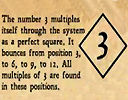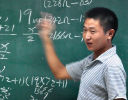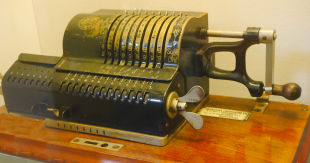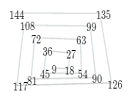IntMath Newsletter: Tesla multiplication map, resources
By Murray Bourne, 26 Jul 2016
26 Jul 2016
In this Newsletter:
1. Tesla Map to Multiplication
2. Resource: Better Explained
3. Math in the news: China's own Good Will Hunting
4. Math technology history - pinwheel mechanical calculator
5. Math puzzles
6. Final thought: Universal passport?
1. Tesla Map to Multiplication
(a) 3D animation of Tesla's Map to Multiplication
(b) The real story behind the Tesla Map to Multiplication
 |
The fascinating Map to Multiplication may not be all it seems, notwithstanding its cleverness. |
2. Resource: Better Explained
Better Explained covers a wide range of math topics using intuitive and easy-to-follow methods, in some cases with interactive activities. Here are some example pages:
- An Intuitive Guide To Exponential Functions and e
- An Interactive Guide To The Fourier Transform
- An Intuitive Introduction To Limits
3. Math in the news: China's own Good Will Hunting?
 |
In the CNN article, China's 'Good Will Hunting?' Migrant worker solves complex math problem, we read about a parcel delivery man with no formal higher math education who has developed an alternative method to verify Carmichael Numbers. |
(A Carmichael number appears to be a prime, based on Fermat's Little Theorem, but turns out to be composite. The first Carnichael number is 561.)
The story is reminiscent of S. Ramanujan's rise to academic prominence with no formal background, and of the movie Good Will Hunting.
4. Math technology history - pinwheel mechanical calculator

Brunsviga Pinwheel Mechanical Calculator
German, circa 1895
I came across this 120 year-old calculator in a museum in Cambridge last year. Here's what the caption said:
This machine can mechanically calculate sums using a complex system of pinwheels coupled with geared carry mechanisms and a counter. Users would input numbers and
turn the handle clockwise for addition and multiplication or counter-clockwise for subtraction and division.Although the principle of such an arithmetic machine was described by Gottfried Leibniz in 1685, it was only in 1873 that there was a practical, affordable design suitable for mass production.
The owner of this particular device was George Udny Yule, appointed Cambridge's first University Lecturer in statistics in 1912.
5. Math puzzles
The puzzle in the last IntMath Newsletter (28 Jun) involved buying a combination of plants.
Correct answers with sufficient explanation (which included reasoning) were given by: Γιώργος, Kai, Nour, Lidia, Don, Rasheed, Helena and Chris.
Some of the solutions included the trivial case of buying 100 yams, but the wording of the question ("I grab a selection of plants...", and "How many of each type ...") suggest the trivial answer shouldn't be included.
It's unfortunate that most school mathematics questions have one clear correct answer, usually arranged that way so it's easier to grade and there is less controversy about fairness. But in the real world, most problems are "fuzzy" and multi-variable, often with several ways to do it and several outcomes. Students should get more experience with such open-ended problems. I think it's good to mention the trivial case as one possible outcome, but I don't think we would include it as a solution in this case.
New math puzzle
The 1st of January 1981 was a Thursday. What day of the week was the first day of the 20th century?
You can leave your responses here.
6. Final thought: Universal passport?
Inequality of wealth distribution is no doubt a big part of recent unfortunate events (in the eyes of many) like Brexit, the shift to the right in Europe and the rise of Donald Trump. Here's a perspective that's worth pondering:
Money is an article which may be used as a universal passport to everywhere except heaven, and as a universal provider for everything except happiness. [Wall Street Journal]
Until next time, enjoy whatever you learn.
See the 14 Comments below.

26 Jul 2016 at 4:11 pm [Comment permalink]
1 January 1981 = Thursday
1 January 2000 = ?
=> 2000-1981 = 19
:.1 Jan 2000 = Thur + 19 days(01/011981 = Mon,01/01/1982 = Tue)
= 19 -: 7 (7 DAYS IN A WEEK)
= Thur + 5 days
= Tuesday
That's what think
26 Jul 2016 at 11:53 pm [Comment permalink]
The interval between 1/01/1981 and 1/01/2000 was 6,939 days; or 1/01/2000 was a Saturday.
27 Jul 2016 at 2:35 am [Comment permalink]
"First day of 20th century" = 1 january 1901
(1/1/1901)
And according to my calendar ? :
1/1/1901 is a "Tuesday".
27 Jul 2016 at 7:03 am [Comment permalink]
Monday: Every general year adds 1 DAY, every leap year adds 2 DAYS, so 20 years = 5 leap years + 15 general years = 5*2+15*1=25 DAYS, divided by 7 gives 21+4, i. e. 4 DAYS ahead= Monday.
27 Jul 2016 at 7:41 am [Comment permalink]
Tuesday
The first day of the 20th century is 01/01/1901 rather than 1/1/1900.
I was born on June 4, 1957, Tuesday. Every 28 years (but after 1900 was not a leap year) always coincide the same day (every four years is a leap year and the week's been seven days: 4x7 = 28), even for those who were born February 29th. Indeed, 01/01/1957 was this Tuesday (31-1 + 28 + 31 + 30 + 31 + 4 = 154 = 7x22). Since then 1957-1901 = 56 = 2x28, then the day 01/01/1901 was Tuesday.
27 Jul 2016 at 1:30 pm [Comment permalink]
It was a Sunday. Continue to produce this paper it is good to us mathematicians
30 Jul 2016 at 8:17 am [Comment permalink]
The number of days between Jan 1 1900 And Jan 1 1981 is
DAYS=((81-1)/4)*366 +(81-1)*3/4)*365 =29200
29200MOD(7) = 3
Now, go back 3 days from Thur.......Monday
Ans = Monday
Note 29200/7 =4171 + 3 I.e. 29200 MOD(7)
30 Jul 2016 at 9:31 pm [Comment permalink]
Hi Murray
and thanks^million for the wonderful Newletters and inspiration!
1 EASY SUGGESTION:
-----------------
In the "Comment permalinks" (in Puzzle Answers, etc), do include a "short link" of the permalink instead of the long URL.
So for ex.,the loooong "Comment permalink":
https://www.intmath.com/blog/letters/intmath-newsletter-3d-planes-resources-200-tb-math-answer-10812#comments
becomes, simply: http://goo.gl/Ly94oG
Much easier to save many bookmark permalinks to Puzzle answers and other interesting intMATH blog content, for future reference... 🙂
thanks!
RAY/SF
31 Jul 2016 at 8:01 am [Comment permalink]
@Ray: Thanks for the kind comments.
Actually, I did have a URL shortening system on IntMath for a year or so, but it messed up search results and I had to abandon it.
I'm not sure where you are saving your bookmarks to, but if it is to MS Word for example, rather than save the long URL, why not save the full link, like this (this comes from the "See the 17 Comments below" bit at the end of the post):
17 Comments
Then change that text to something short and meaningful:
Solutions for plants puzzle
1 Aug 2016 at 2:08 pm [Comment permalink]
First day of the 20th century was 1 January 1901, a Tuesday.
5 Aug 2016 at 12:33 am [Comment permalink]
1St Jan 1900 was a Monday
9 Aug 2016 at 10:21 pm [Comment permalink]
The answer here depends if we consider the 1st day of the 20th C to be 01/01/1900, or 01/01/1901. I'm a purist, so I go for the latter 🙂
So 01/01/1981 minus 01/01/1901 equals 80 years.
60 of these are ordinary years of 365 days, for a total of 21900 days
20 of them are leap years of 366 days, for a total of 7320.
Overall total is 29220 days.
29220 Mod 7 = 2, i.e. if we divide 29220 by 7 there are 2 left over.
Two days back from Thursday is Tuesday, which is the what the 1st of Jan 1901 was.
If we want to go back to the 01/01/1900 for the sake of argument, we need to add on an extra 365 days to our total (1900 wasn't a leap year in the Gregorian calendar). So the total number of days is 29585.
29585 Mod 7 = 3, so we need to go back three days from Thursday, making 01/01/1900 a Monday.
30 Aug 2016 at 9:13 pm [Comment permalink]
Days of the week also depend on when countries adopted the Gregorian calendar. Greece, Russia and 6 or 7 other countries with names ending with "ia" were using the Julian calendar on 1-1-1901. To them, the day of the week would have been a Monday.
Test your day of the week algorithm for 9-13-1752.
1 Sep 2016 at 4:14 pm [Comment permalink]
@Rick: Very good point! We all assume *our* calendar is what everyone else uses. It's amazing how long the Julian calendar, with all its inaccuracies, lasted. We'll be saying the same thing about the British units of weights and measures sometime...